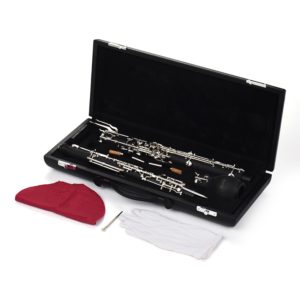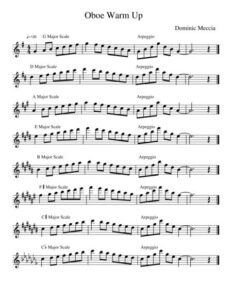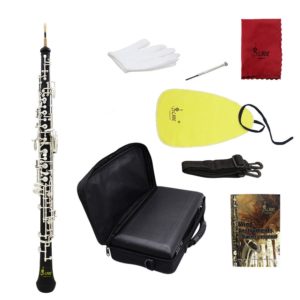Mastering the Oboe:
A Comprehensive Guide for Beginners and Intermediate Oboe Players
Listen to the Audio “Mastering the Oboe”

Are you ready to embark on a musical journey with the enchanting sound of the oboe? Whether you are a complete beginner or an intermediate player looking to sharpen your skills, “Mastering the Oboe: A Comprehensive Guide for Beginners and Intermediate Players” is your ultimate companion.
This expertly crafted guide is designed to help you navigate the intricacies of this unique instrument, providing you with the knowledge and techniques needed to master its melodic charm. From understanding the fundamentals of playing the oboe to exploring advanced techniques and repertoire, this comprehensive resource covers it all. With step-by-step instructions, practical exercises, and valuable tips from seasoned professionals, you will unlock your full potential and become a confident oboist.
So, whether you dream of performing on stage or simply want to indulge in the joy of playing the oboe, this guide is your key to unlocking a world of musical possibilities. Get ready to take your oboe playing to new heights and immerse yourself in the captivating world of this timeless instrument.
Choosing the Right Oboe
When it comes to choosing an oboe, it’s important to find one that suits your needs and preferences. There are various types of oboes available, including student models, intermediate models, and professional models. Student models are typically more affordable and designed for beginners, while professional models offer superior craftsmanship and are suitable for advanced players.
Consider factors such as your budget, playing level, and long-term goals when making your decision. It’s also recommended to try out different oboes before making a purchase, as each instrument has its own unique sound and feel.
Understanding the Different Parts of the Oboe
To become a proficient oboist, it’s essential to familiarize yourself with the different parts of the oboe. The main components include the reed, the body, the keys, and the bell. The reed is responsible for producing sound when air is blown through it, while the body houses the key mechanism and controls the pitch. The keys are used to cover and uncover the tone holes, allowing the player to create different notes. Lastly, the bell helps to amplify the sound produced by the oboe. Understanding the function of each part will enable you to better control the instrument and produce a desirable tone.
Proper Oboe Maintenance and Care
Taking proper care of your oboe is crucial for maintaining its playability and longevity. Regular cleaning and maintenance will help prevent build-up of dirt, moisture, and bacteria. After each practice session or performance, make sure to clean the instrument thoroughly using a cleaning swab and a soft cloth.
Additionally, store your oboe in a protective case to shield it from dust and potential damage. It’s also important to periodically check for any signs of wear or damage and have your oboe serviced by a professional if necessary. By adopting good maintenance habits, you’ll ensure that your oboe remains in optimal condition for years to come.
Basic Techniques of The Oboe
Before diving into more advanced techniques, it’s important to master the basic oboe techniques. Start by learning how to hold the oboe properly, ensuring a comfortable and relaxed grip. Next, focus on developing good embouchure, which involves shaping your lips and mouth to produce a clear and resonant sound.
Proper finger placement and coordination are also essential for playing the correct notes. Practice playing long tones and simple melodies to build your finger dexterity and breath control. Remember to start slowly and gradually increase your speed and difficulty level as you gain confidence.
Developing Good Posture and Breath Control
Good posture and breath control are fundamental aspects of oboe playing. Maintaining an upright posture with relaxed shoulders and a straight back will not only improve your playing technique but also prevent strain and potential injuries.
Take the time to develop a solid breathing technique, focusing on deep breaths from the diaphragm. This will allow you to produce a consistent and controlled sound. Practice exercises such as long tones and breath exercises to strengthen your breath support and increase your playing endurance. With consistent practice, you’ll develop a strong foundation for your oboe playing.
Learning to Read Sheet Music for The Oboe
To effectively play the oboe, it’s essential to become proficient in reading sheet music. Familiarize yourself with the musical staff, notes, and rhythms commonly used in oboe music. Learn to identify the different note durations, such as whole notes, half notes, quarter notes, and eighth notes.
Practice sight-reading exercises to improve your ability to quickly interpret and play written music. As you progress, challenge yourself with more complex pieces that require sight-reading skills. Remember to take your time and gradually build your reading proficiency.
Essential Oboe Scales and Exercises

Mastering scales and exercises is a crucial part of oboe playing. Start by learning the major scales, which are the foundation for understanding key signatures and music theory. Practice playing these scales in different octaves and variations to improve your finger technique and familiarity with different key signatures.
Additionally, incorporate technical exercises that focus on specific aspects of oboe playing, such as articulation, finger agility, and dynamic control. Regularly practicing scales and exercises will not only enhance your technical skills but also improve your overall musicality.
Common Oboe Playing Techniques and Articulations
Beyond the basic techniques, there are a variety of additional playing techniques and articulations that add depth and expression to your oboe playing. These include staccato, legato, slurs, trills, and vibrato, among others. Each technique produces a distinct sound and adds character to your playing.
Experiment with these techniques and practice incorporating them into your repertoire. Pay attention to nuances such as phrasing and dynamics to further enhance your musical interpretation. With time and practice, you’ll develop a versatile and expressive oboe playing style.
Tips for Improving Oboe Tone and Intonation
Achieving a beautiful and well-balanced tone is a goal for every oboist. To improve your tone, focus on developing a relaxed embouchure and consistent breath support. Experiment with different reeds to find one that suits your playing style and produces the desired tone quality. Regularly practice long tones and tone exercises to refine your sound production and intonation.
It’s also important to actively listen to professional oboists and seek feedback from teachers or mentors to further improve your tone and intonation. With dedication and attention to detail, you’ll be able to produce a rich and captivating sound on the oboe.
Transitioning from Beginner to Intermediate Level
As you progress on your oboe journey, you’ll eventually reach the intermediate level. This stage requires a deeper understanding of musical concepts and a wider repertoire. Continue building on your foundation by exploring more challenging pieces and technical exercises. Work on refining your technique, tone, and musical interpretation.
Seek opportunities to perform in ensembles or with other musicians to further develop your ensemble skills and musicality. Set goals for yourself and strive for continual improvement. The transition from beginner to intermediate level is an exciting phase that opens doors to more advanced musical possibilities.
Advanced Oboe Techniques and Repertoire
For those aiming to reach the highest level of oboe playing, the pursuit of advanced techniques and repertoire is essential. This includes mastering complex fingerings, extended techniques, and advanced musical concepts. Study advanced oboe repertoire from various musical periods to broaden your musical knowledge and technical skills. Experiment with different musical styles and genres to expand your artistic versatility.
Seek guidance from experienced oboists or instructors who can provide valuable insights and mentorship. With dedication, perseverance, and a commitment to lifelong learning, you’ll continue to grow as an oboist and push the boundaries of your musical capabilities.
Finding Opportunities for Oboe Performance
Once you’ve developed a solid foundation and a repertoire of pieces, it’s time to seek opportunities for oboe performance. Look for local community ensembles, school bands, or orchestras where you can showcase your skills and gain valuable performance experience. Participate in music competitions or festivals to challenge yourself and receive feedback from industry professionals. Collaborate with other musicians or form chamber groups to explore ensemble playing.
Additionally, consider offering your services as a freelance oboist for weddings, events, or recording sessions. Embrace every opportunity to share your love for the oboe with others and continue honing your performance skills.
Oboe Resources and Further Learning
In the digital age, there is a wealth of resources available to support your oboe learning journey. Explore online platforms and websites that offer oboe tutorials, exercises, and sheet music. Join online oboe communities or forums where you can connect with fellow oboists and exchange tips and experiences. Seek out recordings and performances by renowned oboists to gain inspiration and broaden your musical horizons.
Additionally, consider attending oboe workshops, masterclasses, or summer programs where you can learn from esteemed oboe professionals. Never stop seeking knowledge and opportunities to grow as a musician.
Conclusion to Mastering the Oboe

Mastering the oboe is a rewarding and fulfilling endeavour that requires dedication, patience, and a love for music. With the comprehensive guide provided in “Mastering the Oboe: A Comprehensive Guide for Beginners and Intermediate Players,” you have all the tools you need to embark on this musical journey.
From choosing the right instrument to refining your technique, exploring advanced repertoire, and seeking performance opportunities, this guide covers every aspect of your oboe learning and playing experience. Remember to practice consistently, seek guidance from experienced professionals, and enjoy the process. Embrace the enchanting sound of the oboe and let your musical journey unfold.
